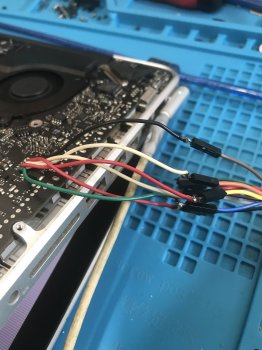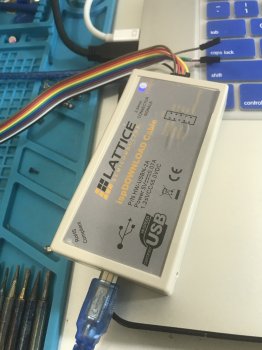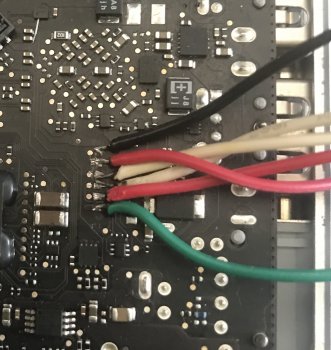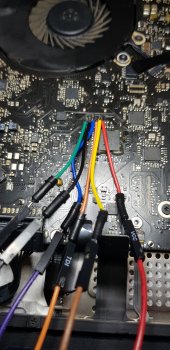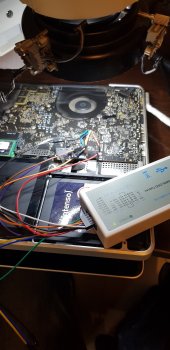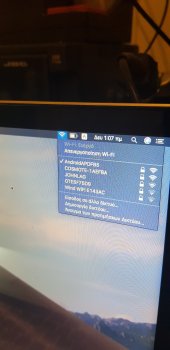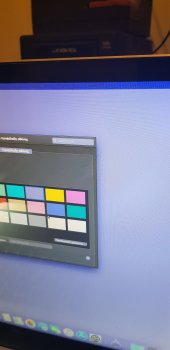Thank you so much dosdude1 happy Easter everyoneHave it a little early: https://computeco.de/Demux
Got a tip for us?
Let us know
Become a MacRumors Supporter for $50/year with no ads, ability to filter front page stories, and private forums.
MBP 1,1-10,2 Permanently Disable 2011 15"/17" MacBook Pro Dedicated GPU - gMux IC Bypass
- Thread starter dosdude1
- Start date
- Sort by reaction score
You are using an out of date browser. It may not display this or other websites correctly.
You should upgrade or use an alternative browser.
You should upgrade or use an alternative browser.
Always the same error (An error occured while flashing gMux IC.Your licence is still valid).Have it a little early: https://computeco.de/Demux
I try it to 17" MBP 2011 820-2914 my JTAG connections is 100% right and the lattice light green.
After the first try i take the error and after that there is no image only chime i restart the PC and the MBP several times but always the same error .
I know my licence is valid but i can't use it if take always error,my customer wait that i promise what can i do now?
I try another windows pc but i say invalid licence always,now i have in mind to replace the gmux with another from donor board and try again .
For avoid the gmux rebbaling i try the licence to another MBP 15" 2011 820-2915 still the same (An error occured while flashing gMux IC.Your licence is still valid) black screen after error again.
You think something?
Last edited:
Am having the very same issue on my 15” MacBook Pro 2011 board....checked my soldering over several times to make sure it was correct and it was...ran the program over again and the same error keeps popping backup...though i ordered a bad programming...but I guess am not the only getting this issue.Always the same error (An error occured while flashing gMux IC.Your licence is still valid).
I try it to 17" MBP 2011 820-2914 my JTAG connections is 100% right and the lattice light green.
After the first try i take the error and after that there is no image only chime i restart the PC and the MBP several times but always the same error .
I know my licence is valid but i can't use it if take always error,my customer wait that i promise what can i do now?
I try another windows pc but i say invalid licence always,now i have in mind to replace the gmux with another from donor board and try again .
For avoid the gmux rebbaling i try the licence to another MBP 15" 2011 820-2915 still the same (An error occured while flashing gMux IC.Your licence is still valid) black screen after error again.
You think something?
Can you send a picture of your wiring? I have noticed that flashing is somewhat finicky sometimes, as the JTAG lines seem to be very sensitive to noise.Am having the very same issue on my 15” MacBook Pro 2011 board....checked my soldering over several times to make sure it was correct and it was...ran the program over again and the same error keeps popping backup...though i ordered a bad programming...but I guess am not the only getting this issue.
Can you send a picture of your wiring? I have noticed that flashing is somewhat finicky sometimes, as the JTAG lines seem to be very sensitive to noise.
Attachments
There is I cut the wires half and same length and the jod done at first try today.Can you send a picture of your wiring? I have noticed that flashing is somewhat finicky sometimes, as the JTAG lines seem to be very sensitive to noise.
[doublepost=1555863862][/doublepost][doublepost=1555864048][/doublepost]
Attachments
Last edited:
Hmm, that's odd, you should have. Did you verify that you entered the correct email address? You may also want to check your spam folder. As for getting 5, just PM me and I'll send you a code.Hi Collin,
I ordered one and request price for 5 license. I didnt get any confirmation email or anything.
Did re-doing it prove successful...because it still failed for me after I re-soldered the joints and jtag?There is I cut the wires half and same length and the jod done at first try today.
[doublepost=1555863862][/doublepost]
[doublepost=1555864048][/doublepost]
I have this issue after gmux flash any advice?
Except of that distortion mbp works fine.[/Q
can you share . file rom gmux flash
Hi Collin,
Did you get my msg regarding the paid license that i did receive?
[doublepost=1555987561][/doublepost]Hi Collin,
Apologies.
I got the serial key license in Junk box. Anyway Will you able to send me a coopn for 5 licenses? I have sent you PM and mailed you as well.
Did you get my msg regarding the paid license that i did receive?
[doublepost=1555987561][/doublepost]Hi Collin,
Apologies.
I got the serial key license in Junk box. Anyway Will you able to send me a coopn for 5 licenses? I have sent you PM and mailed you as well.
Recently, I figured out a very good solution to PERMANENTLY disable the dedicated AMD video card on a 2011 15"/17" MacBook Pro (MacBookPro8,2/8,3)! For those of you who don't know, MacBook Pros that utilize dynamic GPU switching between a dedicated GPU and integrated GPU use an IC known as the "gMux" chip. This is simply an off-the-shelf micro-controller, programmed with special firmware that switches active GPUs on-the-fly in a MacBook Pro system. This IC has 3 sets of LVDS lines connecting to it: The LVDS output lines from the dedicated GPU, the LVDS output lines from the integrated GPU, and the LVDS lines connecting to the connector for the display. In order to accomplish dynamic GPU switching, all this IC does is, when told to by the system, routes the correct set of LVDS lines to the display's LVDS output on the logic board.
In order to permanently keep the dedicated GPU disabled, there are 2 options:
- Option A, which will be detailed below, is to hard-wire the LVDS output lines from the integrated graphics straight to the lines connecting to the display.
- Option B would be to re-program the gMux IC (which is simply a Lattice LFXP2 FPGA), with a custom firmware to disable the GPU switching functionality. I may experiment with this in the future, but doing so requires special hardware that I don't have. This would, of course, be the optimal solution, though. EDIT: I have now done this, and it works perfectly! More details can be found by watching my video demonstrating my custom gMux IC firmware.
Performing the Modification ("Option A")
Before I get started with the explanation, I just want to make it clear this this is a VERY tedious modification, and requires precision soldering equipment. Use of a microscope is recommended.
To begin, here is a brief look at the schematic, and the main premise of this mod. In the following pictures, you can see how the LVDS data lines appear for both the integrated graphics output, dedicated graphics output, and the LVDS output for the display (EG for dedicated GPU, IG for integrated GPU, and CONN of course for connector). You can see how this data line corresponds with each set of LVDS lines. There are 12 total LVDS lines (6 pairs).
View attachment 777903 View attachment 777904 View attachment 777905
In order to perform this modification,the first thing that needs to be done is to remove the gMux IC. EDIT: Do NOT remove the gMux IC. After further experimentation, I found that leaving it in place will allow you to achieve full graphics acceleration WITHOUT flashing the system firmware at all. Simply proceed with the wiring, with the gMux IC in place.
Once the chip is removed and the pads are cleaned, each LVDS data line from the LVDS_IG side needs to be connected to its corresponding data line on the LVDS_CONN side. Of course, to do this, the use of small bodge wires is required. I used 0.1MM jumper wire (which can be purchased here). A wire needs to be used to connect each IG data line to its respective point on the CONN side.
Here is a wiring diagram that will help you do this very easily. This one is for a 15" machine, but I will update this post with the 17" one once I make it.
View attachment 779000
Once all the data lines are soldered properly, there are still a couple more lines that need to be soldered. We'll start with the clock lines. If you look on the schematic, you will notice that there is one set of clock lines on the LVDS_IG side (LVDS_IG_A_CLK), but 2 sets on the LVDS_CONN side (LVDS_CONN_A_CLK and LVDS_CONN_B_CLK). All you need to do in this instance is connect the A_CLK pair from the IG side to the A_CLK resistor pair on the CONN side. Then, simply connect the A_CLK pair to the B_CLK pair on the CONN side as well.
The next thing we need to do is pull the LVDS_DDC_SEL_IG rail high. To do this, all you need to do is connect the high side of this rail's pulldown resistor (R6982) to the PP3V3_S0 rail. I connected it to a capacitor near the backlight IC (C9711), as it was the easiest and closest source of PP3V3_S0 to that point of the board. This routes the necessary LVDS DDC clock lines to the integrated GPU.
The last few things we need to wire up are the enable rails for the LCD backlight and LCD panel power, as well as the PWM signal for the backlight. The first wire simply needs to bridge the following rails: LCD_PWR_EN, LVDS_IG_PANEL_PWR, and LCD_BKLT_EN.
The last wire will be used to wire the backlight PWM signal. The purpose of this signal is to control the backlight brightness level. Now, normally, the PWM signal is generated by the gMux IC. However, since the gMux IC is no longer in place, it cannot provide this signal (and even if you were to leave it in place, it still would not be able to provide this signal. I may be wrong on this, but feel free to test if you want.) As such, we will simply be wiring this rail to the LVDS_IG_BKL_ON rail. Unfortunately, what this means is that the backlight will remain at a fixed brightness, and be uncontrollable from the OS.
UPDATE: I have finished working on a new solution for backlight brightness control! You can read about, and see this modification in action here.
Finally, once all that is wired up, the system should be good to go! The final product will look something like this:
View attachment 777906
Last Step
After all your wiring is complete, you will need to cut power to the dedicated GPU, otherwise it will simply produce waste heat. To do so, all you need to do is remove the resistor that supplies power to the GPU VCORE regulator IC, R8911.
At last, once all that is complete, you are now done! You will now have a fully working 2011 15" or 17" MacBook Pro, running off ONLY integrated graphics! No OS X modifications are necessary, and it is not reliant on any NVRAM variable (obviously). This, short of making custom firmware for the gMux chip, is the BEST solution for rectifying the defective AMD GPU issue on these machines. The only issues are the lack of brightness control as mentioned earlier, and the external display port will not work. Other than that, though, everything works perfectly!
I have a video showing the mod in detail here.
View attachment 777910
Hi Dosdude1;
I have followed the instructions above, I have back light but no video.
I have checked all solder points on the jump wire and correct lvds point to point, although I have removed the resistors on the lvds_conn side. will this make much of difference?
As an Amazon Associate, MacRumors earns a commission from qualifying purchases made through links in this post.
With the eMux Flash method, would you be able to use an external monitor? I have plans to take a broken Macbook Pro and turning it into a desktop PC, just want to make sure I'm not wasting my time.
With the eMux Flash method, would you be able to use an external monitor? I have plans to take a broken Macbook Pro and turning it into a desktop PC, just want to make sure I'm not wasting my time.
with the cable method (bypass gmux) you can set the resistor r9680 to r9679, disconnect the internal display and then goes only the external monitor. Tested on the 820-2915 board.
I do not know if that's the gmux flash method. I did not test that.
with the cable method (bypass gmux) you can set the resistor r9680 to r9679, disconnect the internal display and then goes only the external monitor. Tested on the 820-2915 board.
I do not know if that's the gmux flash method. I did not test that.
I have the late 2011 Macbook Pro 15" i7 model with GPU issues, not sure which model board that is. How would one set the resistor? Is there a guide on that?
I have the late 2011 Macbook Pro 15" i7 model with GPU issues, not sure which model board that is. How would one set the resistor? Is there a guide on that?
15 inch 2011 = 820-2915
17 inch 2011 = 820-2914
The external video output is wired directly to the dGPU, so any method of disabling the dGPU you use will result in an unusable external display output.With the eMux Flash method, would you be able to use an external monitor? I have plans to take a broken Macbook Pro and turning it into a desktop PC, just want to make sure I'm not wasting my time.
The external video output is wired directly to the dGPU, so any method of disabling the dGPU you use will result in an unusable external display output.
can you share . file rom gmux flash
thanks advance
Register on MacRumors! This sidebar will go away, and you'll see fewer ads.


